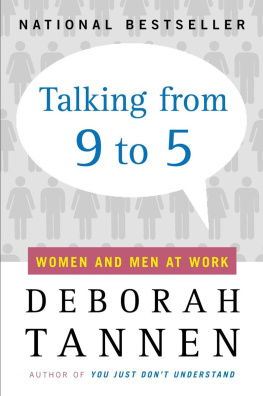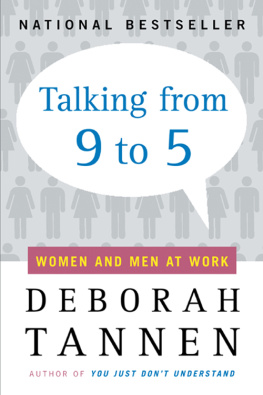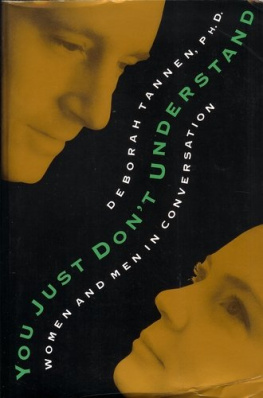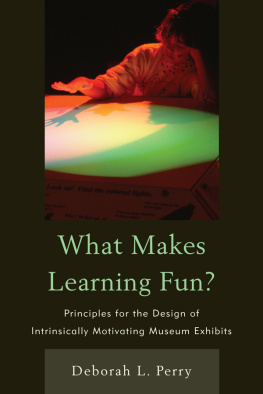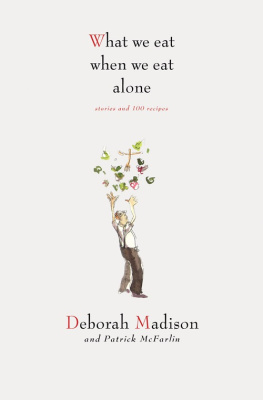Deborah Tannen - That’s Not What I Meant!: How Conversational Style Makes or Breaks Relationships
Here you can read online Deborah Tannen - That’s Not What I Meant!: How Conversational Style Makes or Breaks Relationships full text of the book (entire story) in english for free. Download pdf and epub, get meaning, cover and reviews about this ebook. year: 1991, genre: Science. Description of the work, (preface) as well as reviews are available. Best literature library LitArk.com created for fans of good reading and offers a wide selection of genres:
Romance novel
Science fiction
Adventure
Detective
Science
History
Home and family
Prose
Art
Politics
Computer
Non-fiction
Religion
Business
Children
Humor
Choose a favorite category and find really read worthwhile books. Enjoy immersion in the world of imagination, feel the emotions of the characters or learn something new for yourself, make an fascinating discovery.
- Book:That’s Not What I Meant!: How Conversational Style Makes or Breaks Relationships
- Author:
- Genre:
- Year:1991
- Rating:5 / 5
- Favourites:Add to favourites
- Your mark:
- 100
- 1
- 2
- 3
- 4
- 5
That’s Not What I Meant!: How Conversational Style Makes or Breaks Relationships: summary, description and annotation
We offer to read an annotation, description, summary or preface (depends on what the author of the book "That’s Not What I Meant!: How Conversational Style Makes or Breaks Relationships" wrote himself). If you haven't found the necessary information about the book — write in the comments, we will try to find it.
That’s Not What I Meant!: How Conversational Style Makes or Breaks Relationships — read online for free the complete book (whole text) full work
Below is the text of the book, divided by pages. System saving the place of the last page read, allows you to conveniently read the book "That’s Not What I Meant!: How Conversational Style Makes or Breaks Relationships" online for free, without having to search again every time where you left off. Put a bookmark, and you can go to the page where you finished reading at any time.
Font size:
Interval:
Bookmark:
Thats Not
What
I Meant!
How Conversational Style Makes
or Breaks Relationships Deborah Tannen
DEBORAH TANNEN

To my teachers in linguistics:
A. L. Becker
Wallace L. Chafe
John J. Gumperz
Robin Tolmach Lakoff
who selflessly gave me the insights of their work to form the foundation of mine, even as they encouraged me to do my own work and to write and talk about it in my own voice, both within and beyond the bounds of academia
Contents
A student who took the course on cross-cultural communication that I teach in the Linguistics Department at Georgetown University commented that the course saved her marriage. At scholarly meetings, my fellow linguists stop me in the hall to tell me that they showed one of my articles to friends or relatives, and it saved their marriages.
What can linguistics have to do with saving marriages? Linguistics is the academic discipline devoted to understanding how language works. Relationships are made, maintained, and broken through talk, so linguistics provides a concrete way of understanding how relationships are made, maintained, and broken. There are branches of linguistics that are concerned mainly with the history or the grammar or the symbolic representation of language. But there are also branches of the fieldsociolinguistics, discourse analysis, and anthropological linguisticsthat are concerned with understanding how people use language in their everyday lives, and how people from different cultures use language in different ways. This book grows out of these branches of linguistics.
But the student who said my course saved her marriage and her husband are both American. What does cross-cultural communication have to do with them? It has to do with everyone, because all communication is more or less cross-cultural. We learn to use language as we grow up, and growing up in different parts of the country, having different ethnic, religious, or class backgrounds, even just being male or femaleall result in different ways of talking, which I call conversational style. And subtle differences in conversational style result in individually minor but cumulatively overwhelming misunderstandings and disappointments.
As the novelist E. M. Forster put it in A Passage to India, a pause in the wrong place, an intonation misunderstood, and a whole conversation went awry. When conversations go awry, we look for causes, and usually find them by blaming others or ourselves. The most generous-minded among us blame the relationship. This book shows how much of this blame is misplaced. Bad feelings are often the result of misunderstandings that arise from differences in conversational style.
A talk-show host once introduced me by saying that in his long career he had read many books about speaking, but they were all about public speaking. Yet most of the talk we engage in during our lives is not public but private speaking: talk between two or among a few people. This book is about private speaking: how it works, why it goes well sometimes and badly at other times. It explains the invisible processes of conversational style that shape relationships. Understanding these processes restores a sense of control over our lives, making it possible to improve communication and relationships in all the settings in which people talk to each other: at work, in interviews, in public affairs, and most important of all, at home.
I.
Linguistics and
Conversational Style
Chapter One
The Problem Is the Process
Y ou know the feeling: You meet someone for the first time, and its as if youve known each other all your lives. Everything goes smoothly. You know just what she means; she knows just what you mean. You laugh at the same time. Your sentences and hers have a perfect rhythm. You feel terrific; youre doing everything right. And you think shes terrific too.
But you also know the other feeling: You meet someone, you try to be friendly, to make a good impression, but everything goes wrong. There are uncomfortable silences. You fish for topics. You bump into each other as you both start at once and then both stop. You start to say something interesting but he cuts you off. He starts saying something and never seems to finish. You try to lighten the mood and he looks as if you punched him in the stomach. He says what may be intended as a joke but is more rude than funny. Whatever you do to make things better makes them worse.
If conversation always followed the first pattern, I wouldnt have to write this book. If it always followed the second, no one would ever talk to anyone else and nothing would get done. Talk is mostly somewhere in the middle. We do get things done; we talk to family and friends and colleagues and neighbors. Sometimes what people say seems to make perfect sense; sometimes it sounds a little odd. If someone doesnt quite get our point, we let it go, the talk continues, and no one pays much attention.
But if an important outcome hangs on the conversationif its a job interview, a business meeting, or a doctors appointmentthe results can be very serious. If its a public negotiation or an international summit conference, the results can be dire indeed. And if the conversation is with the most important person in your life, the little hitches can become big ones, and you can end up in a conversation of the second sort without knowing how you got there. If this happens all the timeat home, at work, or in routine day-to-day encounters, so that you feel misunderstood all the time and never quite understand what others are getting atyou start to doubt your own ability, or even your sanity. Then you cant not pay attention.
For example, Judy Scott is applying for a job as office manager at the headquarters of an ice-cream distributora position shes well qualified for. Her last job, although it was called administrative assistant, actually involved running the whole office, and she did a great job. But at the interview, she never gets a chance to explain this. The interviewer does all the talking, Judy leaves feeling frustrated and she doesnt get the job.
Or at home: Sandy and Matt have a good marriage. They love each other and are quite happy. But a recurring source of tension is that Sandy often feels that Matt doesnt really listen to her. He asks her a question, but before she can answer, he asks anotheror starts to answer it himself. When they get together with Matts friends, the conversation goes so fast, Sandy cant get a word in edgewise. Afterward, Matt complains that she was too quiet, though she certainly isnt quiet when she gets together with her friends. Matt thinks its because she doesnt like his friends, but the only reason Sandy doesnt like them is that she feels they ignore her and she cant find a way to get into their conversation.
Sometimes strains in a conversation reflect real differences between people: they are angry at each other; they really are at cross-purposes. Books have been written about this situation: how to fight fair, how to assert yourself. But sometimes strains and kinks develop when there really are no basic differences of opinion, when everyone is sincerely trying to get along. This is the type of miscommunication that drives people crazy. And it is usually caused by differences in conversational style.
A perfectly tuned conversation is a vision of sanitya ratification of ones way of being human and ones place in the world. And nothing is more deeply disquieting than a conversation gone awry. To say something and see it taken to mean something else; to try to be helpful and be thought pushy; to try to be considerate and be called cold; to try to establish a rhythm so that talk will glide effortlessly about the room, only to end up feeling like a conversational clod who cant pick up the beatsuch failure at talk undermines ones sense of competence and of being a right sort of person. If it happens continually, it can undermine ones feeling of psychological well-being.
Font size:
Interval:
Bookmark:
Similar books «That’s Not What I Meant!: How Conversational Style Makes or Breaks Relationships»
Look at similar books to That’s Not What I Meant!: How Conversational Style Makes or Breaks Relationships. We have selected literature similar in name and meaning in the hope of providing readers with more options to find new, interesting, not yet read works.
Discussion, reviews of the book That’s Not What I Meant!: How Conversational Style Makes or Breaks Relationships and just readers' own opinions. Leave your comments, write what you think about the work, its meaning or the main characters. Specify what exactly you liked and what you didn't like, and why you think so.



